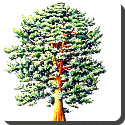 Juniper, Western — Juniperus occidentalis (Western Juniper and Sierra Juniper) is a shrub or tree native to the western United States, growing in mountains at altitudes of 800-3,000 m (rarely down to 100 m).
Juniper, Western — Juniperus occidentalis (Western Juniper and Sierra Juniper) is a shrub or tree native to the western United States, growing in mountains at altitudes of 800-3,000 m (rarely down to 100 m).
The shoots are of moderate thickness among junipers, 1-1.6 mm diameter. The leaves are arranged in opposite decussate pairs or whorls of three; the adult leaves are scale-like, 1-2 mm long (to 5 mm on lead shoots) and 1-1.5 mm broad. The juvenile leaves (on young seedlings only) are needle-like, 5-10 mm long. The cones are berry-like, 5-10 mm in diameter, blue-brown with a whitish waxy bloom, and contain one to three seeds; they are mature in about 18 months. The male cones are 2-4 mm long, and shed their pollen in early spring.
It usually occurs on dry, rocky sites where there is less competition from larger species like Ponderosa Pine and Coast Douglas-fir. Hybrids with Juniperus osteosperma are occasionally found.
The cones are an important food for several birds, including American Robin, Phainopepla and Cedar Waxwing; these digest the fleshy cone scales and disperse the seeds in their droppings. The plants often bear galls caused by the Juniper Tip Midge Oligotrophus betheli (Bibionomorpha: Cecidomyiidae); these are violet-purple fading to brown, 1-2 cm diameter, with dense modified spreading scale-leaves 6-10 mm long and 2-3 mm broad at the base.
 Kids Portal For Parents India Kids Network
Kids Portal For Parents India Kids Network






